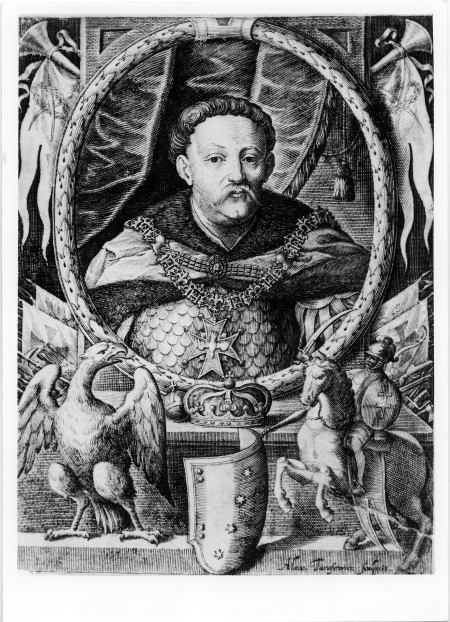
Among numerous portraits of King Jan III Sobieski wearing a type of scale armour called karacena, one clearly stands out. It is a beautiful oil painting from the collection of the Radziwiłł family in Nieborów, created by an unidentified artist at the king’s service, probably shortly after 30 November 1676 (the date when Sobieski was granted the French Order of the Holy Spirit visible in the image). Undoubtedly made from nature, the piece is noted for well executed facial features and a great precision in rendition of details. Consequently, it is considered one of the best portraits glorifying the king-warrior (rex armatus). In line with statutes of the Order of the Holy Spirit, each of the knights was obliged to present his effigy to the chapter gallery of Grands Augustins abbey in Paris. We do not know whether Sobieski complied with the requirement. The portrait allegedly offered to the chapter was one of Jan III which throughout the nineteenth century formed part of the Rapperswil collection. Taken over later by the National Museum in Warsaw, the painting was lost after World War II. Painted were a few more similar portraits of the king.
Soon the Nieborów canvas had its graphic copy of high artistic value made by Aleksander Tarasewicz (Tarasowicz, ca. 1650–1727), a professional copperplate engraver active consecutively in Hłusk [Hlusk], Vilnius and Kiev. The artist reduced the figure of the royal model from below the hips to the bust by placing it in the centre of a larger, glorifying composition. It is set up of such elements as an oval frame of laurel wreath flanked by panoply including flags of the Crown and Lithuania, palm branches and laurel wreaths visible against banners and finally trumpets of the type usually blown by winged Phemes. Particularly interesting are the overlapping forefronts of the portrait. A two-step base holds the regalia (the crown, the orb and the sceptre) as well as three-dimensional emblems of both Poland and Lithuania. Between them and shifted a bit foreword there is Sobieski’s escutcheon (and the Janina coat of arms). By partly covering the national emblems, the escutcheon symbolizes the country’s security under King Sobieski’s rule. The stars visible in the escutcheon, symbols of immortal virtue, grant the Polish monarch a divine and immortal nature, secured by the star constellation discovered by Hevelius and named by him Scutum Sobiescianum. The copperplate engraving by Tarasewicz is a true rarity in Polish collections. Known are two copies of the print, one in reserves of the Princes Czartoryski Foundation, part of the National Museum in Cracow; the other one in the National Library collection, where it came from the former the Library of the Krasiński Entail collection.
Aleksander Tarasewicz (Tarasowicz), based on a painting by an anonymous contemporary painter: Portrait of Jan III Sobieski in karacena, copperplate engraving, after 30 November 1676.
We would like to inform that for the purpose of optimisation of content available on our website and its customisation according to your needs, we use information stored by means of cookies on the Users' end devices. You can control cookies by means of your Internet browser settings. Further use of our website without change of the browser settings means that you accept the use of cookies. For more information on cookies used by us and to feel comfortable about this subject, please familiarise yourselves with our Privacy Policy.
✓ I understand